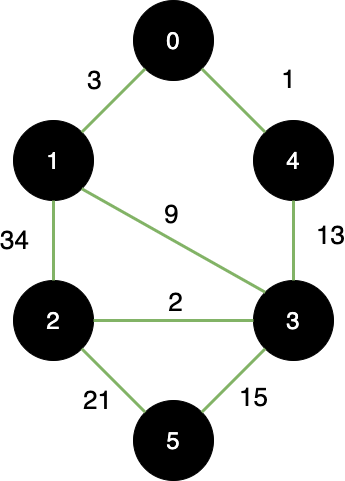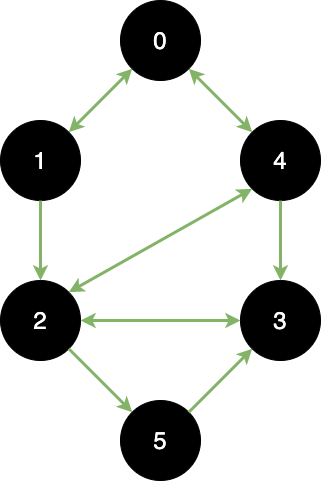探討多個點之間如何聯繫,例如最快速抵達某點?聯繫之間可以補上參數,進而修改最佳路徑。
是不是很有既視感?Google Map 的確使用 Graph 內的演算法:A* algorithm(唸作 A star)。
常見的圖有這幾種:
基本款

加權圖(Weighted Graph)

有向圖(Directed Graph)- 單方向

有向圖(Directed Graph)- 雙方向

有兩種,採用矩陣(二維陣列)或是 Linked List,以下都以基本款為例:
_ 0___1___2___3___4___5
0| 0 1 0 0 1 0
|
1| 1 0 1 1 0 0
|
2| 0 1 0 1 0 1
|
3| 0 1 1 0 1 1
|
4| 1 0 0 1 0 1
|
5| 0 0 1 1 0 0
V0 -> 1 -> 4 -> null
V1 -> 0 -> 2 -> 3 -> null
V2 -> 1 -> 3 -> 5 -> null
V3 -> 1 -> 2 -> 4 -> 5 -> null
V4 -> 0 -> 3 -> null
V5 -> 2 -> 3 -> null
鑑於昨天的經驗,有了基本知識後就來刷題,學習實際做法,避免太高深理論的內容。
In a town, there are N people labelled from 1 to N. There is a rumor that one of these people is secretly the town judge.
If the town judge exists, then:
You are given trust, an array of pairs trust[i] = [a, b] representing that the person labelled a trusts the person labelled b.
If the town judge exists and can be identified, return the label of the town judge. Otherwise, return -1.
Example 1:
Input: N = 2, trust = [[1,2]]
Output: 2
Example 2:
Input: N = 3, trust = [[1,3],[2,3]]
Output: 3
Example 3:
Input: N = 3, trust = [[1,3],[2,3],[3,1]]
Output: -1
Example 4:
Input: N = 3, trust = [[1,2],[2,3]]
Output: -1
Example 5:
Input: N = 4, trust = [[1,3],[1,4],[2,3],[2,4],[4,3]]
Output: 3
Constraints:
1 <= N <= 1000
0 <= trust.length <= 10^4
trust[i].length == 2
trust[i] are all differenttrust[i][0] != trust[i][1]
1 <= trust[i][0], trust[i][1] <= N
題目的意思為,先給予 N 表示有幾個人,再給予陣列 trust,trust 內的每個項目陣列,代表項目零信任項目一,最後判斷,是不是有一個人,除了自己之外,被所有村民信任。
簡單來說就是 Directed Graph 的概念,是不是有一個點被所有點連結,另外一點是,該點沒有主動連結到其他人。
JS/**
* @param {number} N
* @param {number[][]} trust
* @return {number}
*/
const findJudge = (N, trust) => {
if (N === 1) {
return N;
}
let trustMap = new Array(N + 1).fill(0);
for (let i = 0; i < trust.length; i++) {
const pair = trust[i];
if (trustMap[pair[1]]) {
trustMap[pair[1]]++;
} else {
trustMap[pair[1]] = 1;
}
if (trustMap[pair[0]]) {
trustMap[pair[0]]--;
} else {
trustMap[pair[0]] = -1;
}
}
for (let key = 0; key < trustMap.length; key++) {
if (trustMap[key] === N - 1) {
return key;
}
}
return -1;
};
Javaclass Solution {
public int findJudge(int N, int[][] trust) {
if (N == 1) {
return N;
}
int[] trustMap = new int[N + 1];
for(int i = 0; i < trust.length; i++) {
int[] pair = trust[i];
trustMap[pair[0]]--;
trustMap[pair[1]]++;
}
for (int key = 0; key < trustMap.length; key++) {
if (trustMap[key] == N - 1) {
return key;
}
}
return -1;
}
}
Cint findJudge(int N, int **trust, int trustSize, int *trustColSize)
{
if (N == 1)
{
return N;
}
int trustMap[10000 + 1] = {0};
int i, key;
for (i = 0; i < trustSize; i++) {
trustMap[trust[i][0]]--;
trustMap[trust[i][1]]++;
}
for (key = 0; key < N + 1; key++) {
if (trustMap[key] == N - 1) {
return key;
}
}
return -1;
}
三題做法一樣,建立一個建立 trustMap 表示被信任的次數(或是看成被連結的次數),實作的重點是:
計算完畢後再找尋,信任次數為總人數 N - 1 的就是 Judge。
這次採用先理解相關概念後直接解題的做法,發現解題時不會完全採用 Graph 的專有名詞,反倒是在組裝 Array 時,腦海中總是浮現一張 Graph ,作為如何操作 Array 的參考。
